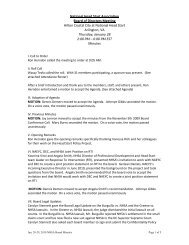New! - National Head Start Association
New! - National Head Start Association
New! - National Head Start Association
You also want an ePaper? Increase the reach of your titles
YUMPU automatically turns print PDFs into web optimized ePapers that Google loves.
comfortable for my colleague, and she still<br />
remains uncomfortable reading aloud to<br />
this day. ough her mother need not have<br />
worried, her fear was understandable. Particularly<br />
when you consider that at that time<br />
and in the area she lived, her accent was a<br />
barrier to employment.<br />
is worry includes a misunderstanding<br />
of the reasons why reading to young<br />
children is so bene cial. Studies show that<br />
conversation and storytelling are both key to<br />
early brain development and early literacy.<br />
As such, books can be thought of as tools<br />
for developing rich brain-building language<br />
interactions.<br />
Strategies<br />
We can teach parents in a variety of ways<br />
that a book is a wonderful tool with which<br />
to build conversation. Here are some e ective<br />
ways to get that point across, especially<br />
with parents with low or no literacy skills.<br />
Here are a few key things you can<br />
teach parents:<br />
• Children don’t care about mistakes and<br />
they don’t care how well you read. What<br />
they need is to hear a parent’s voice and<br />
to engage in conversation.<br />
• Children are not going to pick up your<br />
accent, and it doesn’t matter if you can<br />
read in English. What does matter is the<br />
quality time you spend with your child<br />
and the fact that you are giving your child<br />
opportunities to use and explore language.<br />
• Storytelling is an excellent alternative that<br />
also helps build cognitive and language<br />
skills, and it is a powerful and e ective<br />
bridge from conversation to reading. It is<br />
Quick tip<br />
22 THE MAGAZINE OF THE NATIONAL HEAD START ASSOCIATION<br />
CHILDREN AND FAMILIES Back-to-School 2008<br />
important to share stories from your own<br />
childhood with your children. is helps<br />
to build vocabulary and helps children<br />
understand sentence structure and syntax.<br />
Storytelling prompts the use of cognitive<br />
skills and imagination in forming mental<br />
images and making predictions, which<br />
then enables children to form their own<br />
stories.<br />
• How to read interactively. e following<br />
wordless book activity is e ective in<br />
making this process easy to learn (without<br />
embarrassing parents with low-literacy<br />
skills).<br />
Wordless book activity<br />
Sharing books without pictures is a very<br />
e ective way to help parents understand<br />
that they can enjoy books without having<br />
to read. In a group setting…<br />
1. Model how to share a wordless book with<br />
a group of parents. Be as interactive as<br />
possible. You can start by role playing,<br />
with you taking on the role of “parent”<br />
and some parents as the “children.” If you<br />
do this, rst model reading non-interactively,<br />
or didactically, and watch the “children”<br />
misbehave and become frustrated.<br />
en model interactive reading.<br />
2. Ask the volunteers and the group for<br />
feedback a er each modeling exercise.<br />
3. Now have the group get into pairs, and<br />
pass out wordless books, one per pair.<br />
Instruct the pairs to role play a parent<br />
and child. e “parent” practices telling<br />
the story by “reading” the pictures to the<br />
“child.” ey can either switch roles a er<br />
a few minutes, or take turns reading to<br />
each other on every other page.<br />
4. Get feedback from the group and discuss<br />
the bene ts of building children’s<br />
vocabularies, of bonding, and so forth.<br />
Find out if they remember reading with<br />
their parents as children. is is a great<br />
opportunity for you to learn more about<br />
the parents with whom you work.<br />
O er supportive praise and encouragement to all families. Make parents feel good about what<br />
they do in terms of rich language conversations with their children, and help them build on these<br />
things. You’ll build their con dence if you help them recognize and build on their strengths.<br />
Barrier #3: My child is too young<br />
to learn to read. Reading is learned<br />
in school.<br />
is used to be a very common belief. In<br />
the past, experts didn’t realize the amount<br />
of brain development that occurs during<br />
the rst few years of life, and they didn’t<br />
understand how early language experiences<br />
prepare children for reading when<br />
they reach school age. Some parents truly<br />
don’t see the point of reading to their child,<br />
especially if their child is too young to speak<br />
or to understand the story.<br />
Strategies<br />
Learning a little about early brain development<br />
is o en useful in overcoming this<br />
belief. Pictures are worth a thousand words,<br />
and brain scans can be especially interesting<br />
to parents. Here are some facts that might<br />
help illustrate the importance of early childhood<br />
experiences:<br />
• Most growth happens early: At age 3, the<br />
brain is 80 percent of its adult size; at age<br />
5, it is 90 percent of its adult size<br />
• ere are critical time periods for specialized<br />
development associates with oral<br />
language, especially grammar and pronunciation.<br />
e window begins to close at 5<br />
years of age.<br />
• Conversation and sharing books during<br />
this period help determine a child’s reading<br />
and thinking ability later on.




